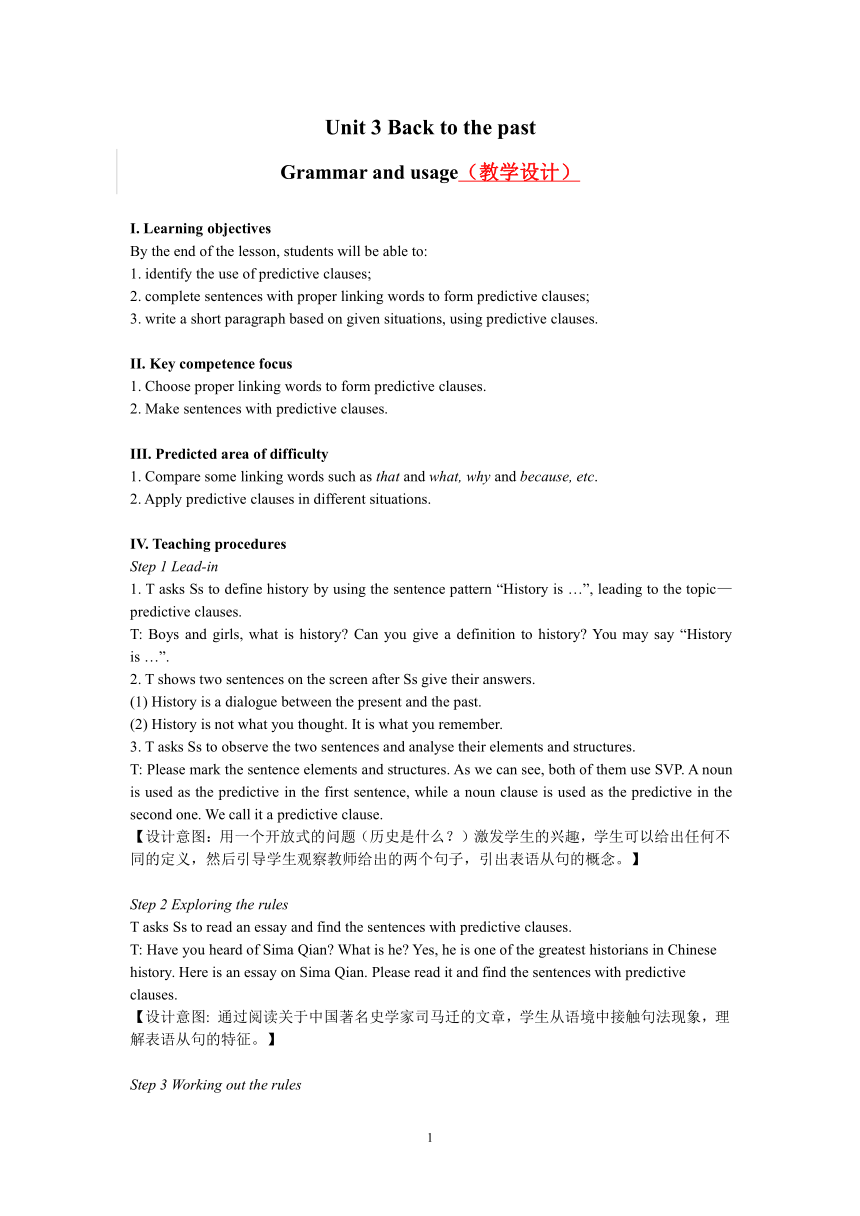
Unit 3 Back to the past Grammar and usage(教学设计) I. Learning objectives By the end of the lesson, students will be able to: 1. identify the use of predictive clauses; 2. complete sentences with proper linking words to form predictive clauses; 3. write a short paragraph based on given situations, using predictive clauses. II. Key competence focus 1. Choose proper linking words to form predictive clauses. 2. Make sentences with predictive clauses. III. Predicted area of difficulty 1. Compare some linking words such as that and what, why and because, etc. 2. Apply predictive clauses in different situations. IV. Teaching procedures Step 1 Lead-in 1. T asks Ss to define history by using the sentence pattern “History is …”, leading to the topic—predictive clauses. T: Boys and girls, what is history Can you give a definition to history You may say “History is …”. 2. T shows two sentences on the screen after Ss give their answers. (1) History is a dialogue between the present and the past. (2) History is not what you thought. It is what you remember. 3. T asks Ss to observe the two sentences and analyse their elements and structures. T: Please mark the sentence elements and structures. As we can see, both of them use SVP. A noun is used as the predictive in the first sentence, while a noun clause is used as the predictive in the second one. We call it a predictive clause. 【设计意图:用一个开放式的问题(历史是什么?)激发学生的兴趣,学生可以给出任何不同的定义,然后引导学生观察教师给出的两个句子,引出表语从句的概念。】 Step 2 Exploring the rules T asks Ss to read an essay and find the sentences with predictive clauses. T: Have you heard of Sima Qian What is he Yes, he is one of the greatest historians in Chinese history. Here is an essay on Sima Qian. Please read it and find the sentences with predictive clauses. 【设计意图: 通过阅读关于中国著名史学家司马迁的文章,学生从语境中接触句法现象,理解表语从句的特征。】 Step 3 Working out the rules 1. Predictive clauses introduced by different linking words. (1) T asks Ss to go through the three sentences above and deduce the rule: We can use that to introduce a predictive clause when the clause is a statement. We can use whether to introduce a predictive clause when the clause is a yes-no question. We can use what, why, when, where, etc. to introduce a predictive clause when the clause is a wh-question. (2) T asks Ss to complete the following sentences. T: Complete the following sentences according to the given Chinese and you will have a better understanding of the rule: 1) My doubt is whether we can get there on time (我们能否准时到那里). 2) The question is who is responsible for the accident (谁为这个事故负责). 3) The problem is how we can raise enough money for the project (我们怎样才能为这个项目筹集到足够的资金). 4) That was where we camped last time (我们上次野营的地方). 5) That’s not what I wanted (我想要的). 6) The truth is that they are fully prepared for the trip (他们已为旅行做了充分准备) ... ...
~~ 您好,已阅读到文档的结尾了 ~~

